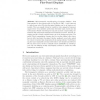Free Online Productivity Tools
i2Speak
i2Symbol
i2OCR
iTex2Img
iWeb2Print
iWeb2Shot
i2Type
iPdf2Split
iPdf2Merge
i2Bopomofo
i2Arabic
i2Style
i2Image
i2PDF
iLatex2Rtf
Sci2ools
PET
2004
Springer
2004
Springer
Electromagnetic Eavesdropping Risks of Flat-Panel Displays
Electromagnetic eavesdropping of computer displays – first demonstrated to the general public by van Eck in 1985 – is not restricted to cathode-ray tubes. Modern flat-panel displays can be at least as vulnerable. They are equally driven by repetitive video signals in frequency ranges where even shielded cables leak detectable radio waves into the environment. Nearby eavesdroppers can pick up such compromising emanations with directional antennas and wideband receivers. Periodic averaging can lift a clearly readable image out of the background noise. The serial Gbit/s transmission formats used by modern digital video interfaces in effect modulate the signal, thereby making it even better suited for remote reception than emanations from analog systems. Understanding the exact transmission format used leads to new attacks and defenses. We can tune screen colors for optimal remote readability by eavesdroppers. We can likewise modify text-display routines to render the radio emanatio...
| Added | 02 Jul 2010 |
| Updated | 02 Jul 2010 |
| Type | Conference |
| Year | 2004 |
| Where | PET |
| Authors | Markus G. Kuhn |
Comments (0)

